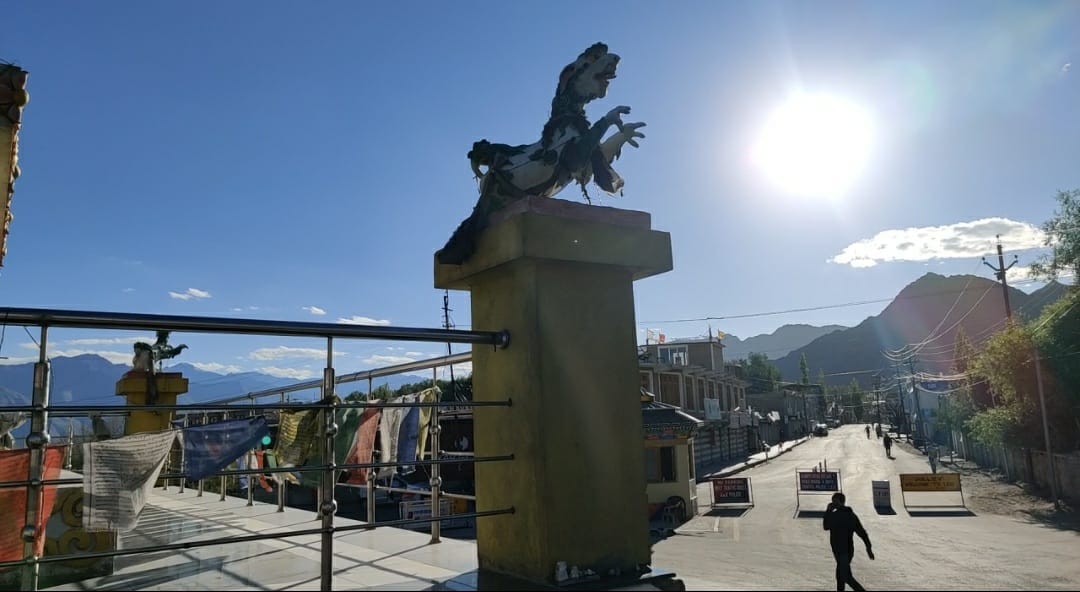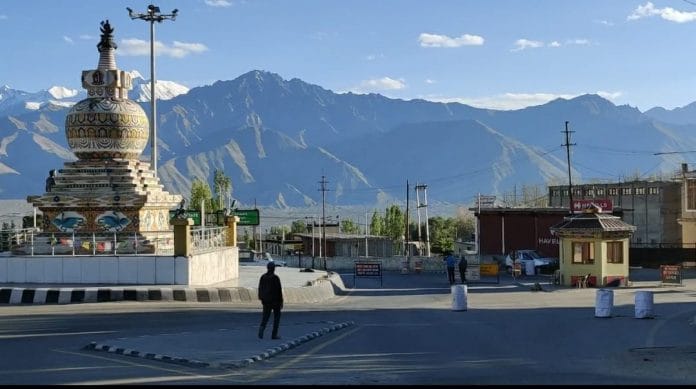Leh: On 21 June, when people rolled out their mats to mark International Yoga Day, Ladakh’s capital Leh woke up to an eerie silence — the result of its first Sunday curfew, imposed due to the rising cases of the novel coronavirus.
Shops remained shut and all passenger and commercial vehicular movement were barred throughout the day. The only disruptions were the Indian Air Force’s sorties, tearing across Leh’s skies every few minutes.
On the road, Indian Army’s trucks and buses moved men and equipment around the town as check posts at every 20 metres ensured no civilian vehicular movement.
Amid all of this, beyond Leh’s city limits, Ladakh MP Jamyang Tsering Namgyal put out his yoga mat and performed asanas against the spectacular backdrop of the Himalayan mountains behind.
ॐ असतो मा सद्गमय
तमसो मा ज्योतिर्गमय
मृत्योर्मा अमृतं गमय
ॐ शान्ति शान्ति शान्ति
Lead me from the unreal to real
Lead me from darkness to light
Lead me from death to immortality
May there be peace everywhere!
May all beings be happy!@narendramodi @moayush @AmitShah @BJP4India pic.twitter.com/h0zd66tWos
— Jamyang Tsering Namgyal (@JTNBJP) June 21, 2020
Over the course of the past week, Ladakh has been fighting on two fronts.
On the one hand is a virus that is spreading its tentacles across the small union territory with cases of the novel coronavirus reaching 836 as of 20 June. But 149 of the cases were recorded on Friday and Saturday alone, prompting the local administration to reimpose lockdown restrictions.
On the other hand is the conflict with China raging in Eastern Ladakh’s Galwan Valley, where 20 Indian soldiers were killed last Monday.
For locals, fighting the combined might of the coronavirus and border face-off with China has meant days of uncertainty writ with nervousness.

Also read: These are the 20 soldiers ‘killed in action’ in Galwan after clashes with Chinese troops
Uncertainty amid border tension
Lubzang works at the petrol pump in Leh’s main Chowk area. His family lives in Durbuk, just 120 km from Galwan Valley, the epicentre of the India-China tensions.
“Mobile connectivity has been cut off since May. My brother went back to the village on 15 June, the day the soldiers died,” he said. “He had told me that things were tense, but now I don’t know what has happened.”
Like Lubzang, Norbu, an Indo-Tibetan Border Police (ITBP) personnel, too hasn’t spoken to his family in over a month. “My house is only 30 km from the border at Rango village. I last spoke to my parents on 6 May,” he said. “Since then, there’s been no communication and now I can’t even go back.”
For locals who have seen the 1999 Kargil War, the build-up is familiar but the lack of information is only adding to the tension.
Abdul Rahman, a constable with Ladakh Police, keeping guard at a makeshift tent with five others on Old Leh Road, said, “My house is near Tololing. During the Kargil War, I could hear grenades day and night. Here we can only see the choppers, planes and the Army vehicles, but we don’t really know what’s happening. This uncertainty is uncomfortable.”
Students who have come back to Leh after the coronavirus lockdown eased say that they don’t know where their future lies. “We have always heard of small incursions by China along the border while growing up. But things were never this serious. We never considered Ladakh to be a conflict zone like Kashmir but now the conflict is at our doorstep,” said Dechen, a student of Delhi University.
Second coronavirus wave hits business & tourism
Adding to the locals woes is the resurgence of the novel coronavirus cases in Ladakh.
The surge in cases has led to a reimposition of lockdown rules.
Shops and vehicles can now only function on an odd-even basis from Monday to Saturday, while Sunday is meant for a complete curfew. The reimposition has meant that business has been severely hit during peak tourist season, which is already low due to the pandemic.
“You won’t even find a room in Leh if you come without reservation in June. But now only a few hotels are open and tourists are nowhere to be seen,” said Atif, whose family owns Hotel Nazeer in Leh.
With no tourists, all businesses have been severely hit. “Last year I made around Rs 4-5 lakhs in this period, but this year I have made close to nothing,” said Tanveer Aziz who owns a tyre business.
Ladakh saw a footfall of 2.3 lakh tourists last year. This year, footfall has been only in thousands. With simmering tension at the border, locals don’t know what this means for their state. “Tourists from all over the world come to visit Pangong Lake. If there’s a war and Pangong goes to China, Ladakh will be over,” Aziz said.
And then there are those who are bearing the combined weight of an ongoing conflict and a pandemic. Nethra, a labourer from Nepal has no work and can’t even go back home. “The government had given us 1 kg rice and pulses and oil but all that is over. I want to go back to Nepal because there’s no work (here), but they’re saying borders are shut. How will I live like this? I have no way out,” he said.
Also read: Ladakh, scenic Himalayan desert at the centre of most fierce India-China conflict in 53 yrs






